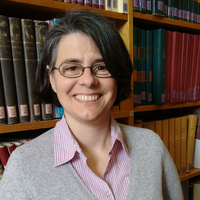
Tatiana Ivleva
I graduated in 2004 in Historical Archivistics (BA with Honours) at Russian State University for the Humanities in Moscow, Russia, and joined in 2006 a MA and later PhD programme in the Faculty of Archaeology in Leiden, the Netherlands.
I had my Doctorate defence in November 2012 with PhD entitled “Britons abroad: the mobility of Britons and the circulation of British-made objects in the Roman Empire”.
My main research interests encompass visual representations and perceptions of identity, mobility, and movement through space, and migrant and diasporic communities. In addition, I am interested in archaeological methods and theories, especially the theory of cultural biographies of artifacts and images.
In 2015 I have received a prestigious Marie Skłodowska-Curie Fellowship from European Commission under Horizon 2020 framework programme for research and innovation (grant agreement number 657309). This two-year postdoctoral fellowship was awarded for the project ‘GLOBALGLASS: Glass Adornments Event Horizon in the Late Iron Age and Roman Period Frontiers (100 BC – AD 250)’. The project was multidisciplinary comparative research on the cross-cultural consumption of personal adornments, known as glass bracelets, used by the inhabitants of the European northwest in the Late Iron Age to Roman period, c. 100 B.C. - A.D. 250. The project investigated the mobility of materials, artefacts and craftspeople, and reconstructed the role of glass bangles in identity formation in the European northwest over the course of six centuries. The interdisciplinary aspect also included the scientific analyses of glass fragments to determine the origin of glass and experimental work with experienced glass artisans to determined bangles’ manufacturing technique.
In addition, my further research includes how Roman sexualities and genders in the provinces and frontiers differed from that of the Mediterranean basin, and the unrecognised multivocal role of hand gestures and gestural combinations in the funerary art of two Roman provinces Noricum and Pannonia (modern-day Austria and Hungary).
I had my Doctorate defence in November 2012 with PhD entitled “Britons abroad: the mobility of Britons and the circulation of British-made objects in the Roman Empire”.
My main research interests encompass visual representations and perceptions of identity, mobility, and movement through space, and migrant and diasporic communities. In addition, I am interested in archaeological methods and theories, especially the theory of cultural biographies of artifacts and images.
In 2015 I have received a prestigious Marie Skłodowska-Curie Fellowship from European Commission under Horizon 2020 framework programme for research and innovation (grant agreement number 657309). This two-year postdoctoral fellowship was awarded for the project ‘GLOBALGLASS: Glass Adornments Event Horizon in the Late Iron Age and Roman Period Frontiers (100 BC – AD 250)’. The project was multidisciplinary comparative research on the cross-cultural consumption of personal adornments, known as glass bracelets, used by the inhabitants of the European northwest in the Late Iron Age to Roman period, c. 100 B.C. - A.D. 250. The project investigated the mobility of materials, artefacts and craftspeople, and reconstructed the role of glass bangles in identity formation in the European northwest over the course of six centuries. The interdisciplinary aspect also included the scientific analyses of glass fragments to determine the origin of glass and experimental work with experienced glass artisans to determined bangles’ manufacturing technique.
In addition, my further research includes how Roman sexualities and genders in the provinces and frontiers differed from that of the Mediterranean basin, and the unrecognised multivocal role of hand gestures and gestural combinations in the funerary art of two Roman provinces Noricum and Pannonia (modern-day Austria and Hungary).
less
Related Authors
Caroline Jackson
The University of Sheffield
Rebecca H Jones
National Museums Scotland
Marenne Zandstra
Radboud University Nijmegen
Stefanie Hoss
Universität zu Köln
Matthew Fittock
University of Reading
Martin Carruthers
University of the Highlands and Islands - UHI
InterestsView All (49)










Uploads
Books by Tatiana Ivleva
In 1949, in the aftermath of a devastating war, Eric Birley organised the First Congress of Roman Frontier Studies. His aim was not only to pursue the study of Roman frontiers but also to take a step towards restoring harmony in international relations within this field of research. The pattern was set early on: the exchange of information, networking and friendship. These three elements remain at the core of the approach of those organising and attending the Congress. They are reinforced by the pattern of the meetings, usually held every three years. The programme includes not only lectures but also visits to the local Roman military sites led by appropriate specialists.
Over the 73 years since the First Congress, membership has grown enormously with more lecture theatres and more coaches being required every meeting. This publication marks the twenty-fifth Congress at Nijmegen in the Netherlands, a city well known to Roman frontier archaeologists and early medieval scholars alike. It aims to help newer members understand the body they have joined; for those who have been attending for longer, it will be a reminder of friendships made and strengthened; for all, the book hopes to be a spur to continuing investigations and research into Rome’s greatest monument, its frontiers; for the moment of publication, it will be a celebration of the twenty-fifth Congress of Roman Frontier Studies.
The volume critically explores the gender constructs and sexual behaviours in the provinces and frontiers in light of recent studies of Roman erotic experience and flux gender identities. At its core, it challenges the unproblematised extension of the traditional Romano-Hellenistic model to the provinces and frontiers. Did sexual relations and gender identities undergo processes of "provincialisation" or "barbarisation" similar to other well-known aspects of cultural negotiation and syncretism in provincial and border regions, for example in art and religion? The 11 chapters that make up the volume explore these issues from a variety of angles, providing a balanced and rounded view through use of literary, epigraphic, and archaeological evidence. Accordingly, the contributions represent new and emerging ideas on the subject of sex, gender, and sexuality in the Roman provinces.
As such, Un-Roman Sex will be of interest to higher-level undergraduates and graduates/academics studying the Roman empire, gender, and sexuality in the ancient world and at the Roman frontiers.
This book is not only a collection of thematically-divided essays dealing with current issues in the Roman provincial studies, it is also a festschrift for Dr Carol van Driel-Murray whose career focused on various aspects of life in the provinces of the Roman Empire. This volume is presented to celebrate achievements of Carol, who has always been keen to tackle entrenched opinions with provocative and profound ideas, and who introduced gender issues in times when this could still lead to a fierce scholarly debate. She is cherished by generations of her former students – many of whom contribute to this volume – as a loved substitute mother: a true Matrona Provinciarum Archaeologiae Romanarum. In line with Carol’s innovative work, the contributions in this volume also challenge long-standing perceptions and provide avenues for further research.
The volume is primarily targeted at academics, researchers, and students of Roman provincial archaeology and history, with particular relevance for frontier specialists and those interested in the material culture. The book will appeal to the re-enactors and those working in experimental archaeology, as few essays discuss at length the subject of experiments and the issues they raise, as well as providing evidence to be tested in the field.
Papers by Tatiana Ivleva
Book Reviews by Tatiana Ivleva
In 1949, in the aftermath of a devastating war, Eric Birley organised the First Congress of Roman Frontier Studies. His aim was not only to pursue the study of Roman frontiers but also to take a step towards restoring harmony in international relations within this field of research. The pattern was set early on: the exchange of information, networking and friendship. These three elements remain at the core of the approach of those organising and attending the Congress. They are reinforced by the pattern of the meetings, usually held every three years. The programme includes not only lectures but also visits to the local Roman military sites led by appropriate specialists.
Over the 73 years since the First Congress, membership has grown enormously with more lecture theatres and more coaches being required every meeting. This publication marks the twenty-fifth Congress at Nijmegen in the Netherlands, a city well known to Roman frontier archaeologists and early medieval scholars alike. It aims to help newer members understand the body they have joined; for those who have been attending for longer, it will be a reminder of friendships made and strengthened; for all, the book hopes to be a spur to continuing investigations and research into Rome’s greatest monument, its frontiers; for the moment of publication, it will be a celebration of the twenty-fifth Congress of Roman Frontier Studies.
The volume critically explores the gender constructs and sexual behaviours in the provinces and frontiers in light of recent studies of Roman erotic experience and flux gender identities. At its core, it challenges the unproblematised extension of the traditional Romano-Hellenistic model to the provinces and frontiers. Did sexual relations and gender identities undergo processes of "provincialisation" or "barbarisation" similar to other well-known aspects of cultural negotiation and syncretism in provincial and border regions, for example in art and religion? The 11 chapters that make up the volume explore these issues from a variety of angles, providing a balanced and rounded view through use of literary, epigraphic, and archaeological evidence. Accordingly, the contributions represent new and emerging ideas on the subject of sex, gender, and sexuality in the Roman provinces.
As such, Un-Roman Sex will be of interest to higher-level undergraduates and graduates/academics studying the Roman empire, gender, and sexuality in the ancient world and at the Roman frontiers.
This book is not only a collection of thematically-divided essays dealing with current issues in the Roman provincial studies, it is also a festschrift for Dr Carol van Driel-Murray whose career focused on various aspects of life in the provinces of the Roman Empire. This volume is presented to celebrate achievements of Carol, who has always been keen to tackle entrenched opinions with provocative and profound ideas, and who introduced gender issues in times when this could still lead to a fierce scholarly debate. She is cherished by generations of her former students – many of whom contribute to this volume – as a loved substitute mother: a true Matrona Provinciarum Archaeologiae Romanarum. In line with Carol’s innovative work, the contributions in this volume also challenge long-standing perceptions and provide avenues for further research.
The volume is primarily targeted at academics, researchers, and students of Roman provincial archaeology and history, with particular relevance for frontier specialists and those interested in the material culture. The book will appeal to the re-enactors and those working in experimental archaeology, as few essays discuss at length the subject of experiments and the issues they raise, as well as providing evidence to be tested in the field.
• Does scholarship from contemporary military sociology provide useful models for application in Rome’s frontiers? Or is human sexuality too deeply enshrined in cultural context and upbringing?
• How was sexuality perceived and represented at the edge of empire? Is there a divergence or alternative to the dominant Romano-Hellenistic model? Is there a ‘provincialization’ or ‘barbarization’ of sex similar to other aspects of cultural negotiation and syncretism?
• Which peoples are being represented, and how?
• What is the role of objects, including architectural adornment, bearing images of genitalia, sex acts, or allusions to such activities?
• Is there a material fingerprint for sexual activities, particularly when considered relative to expectations of organized prostitution linked to the Roman military?
• To what extent can we identify personal representations and material remains of sexuality, distinct from those representations bound up with artistic motifs and political dialogues?